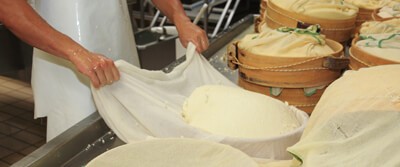Cheese Making, Scientific Methodology, and STEM

By Ellyn Daugherty, Biotechnology: Science for the New Millennium
One challenge facing science educators is giving students experiences that grow their interest in scientific research and applications. A cheese-making lab can emphasize scientific methodology and stimulate interest in science.
How Cheese is Made
For centuries, people made cheese by letting naturally occurring bacteria turn the milk “sour.” Milk curdles, or sours, due to enzyme activity and pH changes. During curdling, the protein in milk (casein) becomes a solid and leaves a liquid (whey) behind. Milk bacteria produce enzymes that use milk sugar and proteins for energy. Some cheese is still made this way, but cheese makers usually want to make more cheese in a shorter time frame than this allows. One method to shorten the process is to add a starter culture of cheese curds (which include milk-curdling bacteria), to milk. The starter culture speeds curdling and the specific microbes help control flavor, odor, texture, and other qualities. Many modern cheeses are produced using this process.
Milk will also curdle within minutes when enzymes like rennin are added. Rennin (also known as chymosin) is a protease or protein enzyme found in calf stomachs. Rennin chops milk protein into smaller pieces that then form loose curds, like cottage cheese. The curds can be pressed to remove the whey and then aged in a variety of ways to produce soft or hard cheeses.
Isolating rennin used to require killing calves and purifying the rennin from other stomach proteins. Therefore, rennin is not vegetarian (the animal is killed) and is expensive to isolate. However, around 1980, scientists realized they could make rennin more efficiently by using recombinant DNA technology. They transferred the cow rennin gene into fungus cells, which read the DNA code and produced the rennin enzyme. Recombinant rennin is basically the same as natural cow rennin, so it chops casein and curdles milk in the same way. Through the years, scientists have modified the genetic code slightly to make recombinant rennin work even better. Because it is easier and cheaper to manufacture rennin in fungi than to isolate it from calves, recombinant rennin is less expensive than cow rennin and is commonly used today to make the majority of cheeses.
Relating Cheese Making to STEM
Making cheese is a powerful vehicle for teaching scientific methodology that brings STEM concepts into the classroom. Many teachers use a cheese-making activity to illustrate enzyme activity because rennin dramatically demonstrates the catalytic nature of enzymes. It’s also fun and easy to make cheese in a classroom lab, and the teacher can design a simple lab activity around it.
Many variables affect the rate and quality of cheese production. In a controlled experiment, the goal is to collect numerical data in order to test and measure the effect of a single variable at a time (i.e. the effect of curdling agent) and minimize the effects of other variables. To conduct a controlled experiment to test the effect of different agents on the rate of milk curdling, begin with a small amount of cheese-making background. Next, ask students to consider which of three curdling agents (bacterial starter, cow rennin, or recombinant rennin) and a control treatment (water) will curdle milk faster. The effect of different curdling agents on the rate (mass/time) of curdling can be measured while other variables (measurement, temperature, etc.) that might affect curdling are identified and minimized.
Making cheese is a good activity to introduce the concept of controlled experiments while giving students their first exposure to common laboratory measurements using pipets, micropipets, balances, and filtering units. It also introduces students to bioethical dilemmas such as the slaughter of animals to retrieve rennin. Finally, students are asked to consider the impact of biotechnological advances on the cheese industry. The cheese-making experiment provides opportunities for students to use scientific methods and apply science, engineering, and technology to solve problems, and it sets the stage for further development of and reflection on lab skills.
Classroom Activities
- Temperature affects enzyme activity: Design a controlled experiment that tests rennin activity at three temperatures between 20°C and 40°C.
- Use the internet to find examples of commercially available cheeses made using cow or recombinant rennin.
- Enzyme
- Protease
- Rennin
- Rennet